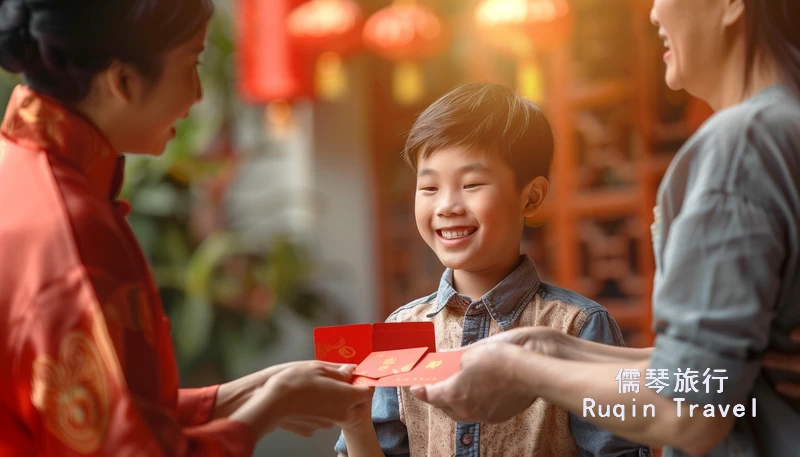China’s rich cultural traditions captivate visitors from around the world. Among these, the Chinese red envelope tradition stands out. Known as “hongbao” in Mandarin, these red envelopes symbolize good luck, prosperity, and happiness.
For foreign tourists, understanding this tradition can enhance your cultural experience in China. This guide will provide you with a comprehensive understanding of the Chinese red envelope tradition, its history, customs, and practical tips for participating in this age-old practice.
The History of the Chinese Red Envelope Tradition
The tradition of giving red envelopes dates back over a thousand years. It originated during the Qin Dynasty (221-206 BC). Initially, people used coins to ward off evil spirits. Over time, these coins were placed in red envelopes, which symbolize luck and protection. The color red itself is significant in Chinese culture, symbolizing happiness, vitality, and good fortune.
During the Tang Dynasty (618-907 AD), red envelopes became popular during Chinese New Year. Families would give children red envelopes with money to wish them good fortune for the coming year. This tradition spread across China and became an integral part of Chinese celebrations.
The Significance of Red Envelopes in Chinese Culture
Red envelopes hold profound significance in Chinese culture. They are not just about the money inside but the goodwill and blessings they represent. Giving a red envelope is a way to express good wishes and share blessings. It fosters a sense of community and caring.
Red envelopes are used in various celebrations, including Chinese New Year, weddings, birthdays, and other special occasions. They are a way to convey best wishes and to show respect and affection. The act of giving and receiving red envelopes strengthens social bonds and reflects the values of generosity and mutual support.
Chinese New Year and Chinese Red Envelopes
Chinese New Year is the most significant festival in China. During this time, giving red envelopes is a cherished tradition. Parents, grandparents, and older relatives give red envelopes to children and younger family members. The amount of money inside varies but is usually an even number, as odd numbers are associated with funerals.
The red envelope tradition during Chinese New Year symbolizes the sharing of good fortune and the wish for a prosperous year ahead. It is believed that receiving a red envelope brings good luck and wards off evil spirits. Therefore, the practice is both a festive and a protective gesture.
Red Envelopes for Weddings
In Chinese weddings, red envelopes play a crucial role. Guests give red envelopes to the bride and groom as wedding gifts. This tradition helps the couple start their new life together with financial support and blessings from friends and family.
The amount of money in wedding red envelopes is usually higher than that for other occasions. The number eight is particularly auspicious, as it sounds like the word for wealth in Mandarin. Therefore, wedding red envelopes often contain amounts like 88, 888, or 8888 yuan, symbolizing wishes for prosperity.
How to Give Red Envelopes
Giving red envelopes involves several important customs. Firstly, you should always use new, crisp bills. Crumpled or old bills are considered disrespectful. Secondly, you should place the money inside a red envelope, which can be purchased in various designs and sizes.
When giving a red envelope, present it with both hands and a warm smile. It is polite to say a blessing or good wish, such as “Gong Xi Fa Cai” (Wishing you great happiness and prosperity). Receiving a red envelope should also be done with both hands, accompanied by words of thanks and good wishes.
Red Envelope Etiquette for Foreigners
As a foreigner, participating in the red envelope tradition shows respect for Chinese culture. However, there are some key etiquette points to remember. Firstly, do not open the red envelope in front of the giver. This is considered impolite. Wait until you are in private to check the contents.
Secondly, if you are giving a red envelope, be mindful of the amount. While there is no fixed rule, even numbers are preferred, and amounts with the number eight are especially favorable. Avoid the number four, as it sounds like the word for death in Mandarin and is considered unlucky.
Red Envelopes for Children
Children are the primary recipients of red envelopes during Chinese New Year and other festivals. The tradition of giving red envelopes to children symbolizes the passing on of good fortune and blessings to the next generation. It is also a way to teach children about generosity and the importance of family bonds.
Children usually receive red envelopes from their parents, grandparents, and other older relatives. The amount of money given to children is generally smaller compared to adults, but it still carries the same significance and blessings.
Modern Red Envelope Practices
In modern times, the red envelope tradition has evolved with technology. Digital red envelopes, or “e-hongbao,” have become popular, especially during Chinese New Year. Apps like WeChat and Alipay allow users to send and receive red envelopes electronically. This modern twist on the tradition has made it more convenient and accessible, especially for younger generations.
Despite the rise of digital red envelopes, the traditional practice of giving physical red envelopes remains strong. Many people still prefer the Traditional Chinese Festivals and personal nature of handing over a red envelope in person. Both practices coexist, blending tradition with modernity.
The Cultural Significance of Red Envelopes
Red envelopes are deeply embedded in Chinese culture. They represent more than just monetary gifts; they embody the values of generosity, goodwill, and social harmony. The tradition of giving red envelopes strengthens family and community bonds, reflecting the collectivist nature of Chinese society.
Moreover, red envelopes serve as a way to convey blessings and best wishes. They are a means of sharing joy and prosperity, fostering a sense of mutual support and care. Understanding the cultural significance of red envelopes can enhance your appreciation of this tradition and help you participate more meaningfully.
Red Envelopes for Special Occasions
While Chinese New Year is the most prominent occasion for red envelopes, they are also given on other special occasions. Weddings, birthdays, and the birth of a child are some events where red envelopes are customary. They are a way to convey good wishes and share in the joy of these milestones.
For instance, at weddings, guests give red envelopes to the bride and groom as a symbol of blessings for their new life together. On birthdays, red envelopes are given to wish the recipient health and happiness. During the birth of a child, red envelopes are given to the parents to congratulate them and wish the baby a prosperous future.
Chinese Red Envelope Colors and Meanings
While red is the most common color for envelopes, other colors can also be used, each carrying its own meaning. For example, gold envelopes symbolize wealth and prosperity. Silver envelopes are often used for weddings, symbolizing purity and new beginnings.
However, it is important to avoid white envelopes, as white is associated with mourning and funerals in Chinese culture. The color of the envelope should reflect the joyous nature of the occasion and the positive wishes you want to convey.
Chinese Red Envelope Do’s and Don’ts
To navigate the red envelope tradition smoothly, here are some key do’s and don’ts:
Do’s:
- Use new, crisp bills.
- Present the envelope with both hands.
- Say a blessing or good wish when giving the envelope.
- Choose even amounts of money, especially those with the number eight.
Don’ts:
- Do not use old or crumpled bills.
- Avoid the number four in the amount given.
- Do not open the envelope in front of the giver.
- Avoid white envelopes, as they are associated with funerals.
Following these guidelines will help you participate in the red envelope tradition respectfully and appropriately.
Frequently Asked Questions (FAQs) about Red Envelopes
Q: Can foreigners give red envelopes? A: Yes, foreigners can give red envelopes. Participating in this tradition shows respect and appreciation for Chinese culture.
Q: How much money should I put in a red envelope? A: There is no fixed rule, but even numbers are preferred. Amounts with the number eight are especially auspicious.
Q: Can I give a red envelope outside of Chinese New Year? A: Yes, red envelopes are given on various occasions, including weddings, birthdays, and the birth of a child.
Q: Is it okay to use digital red envelopes? A: Yes, digital red envelopes are becoming increasingly popular and are a convenient way to participate in the tradition.
Q: What should I say when giving a red envelope? A: It is polite to say a blessing or good wish, such as “Gong Xi Fa Cai” (Wishing you great happiness and prosperity).
The Chinese red envelope tradition is a beautiful and meaningful practice that reflects the values of generosity, goodwill, and social harmony. As a foreigner visiting China, participating in this tradition can enrich your cultural experience and deepen your appreciation of Chinese culture.
By understanding the customs and significance of red envelopes, you can engage with this tradition respectfully and meaningfully. Whether you are receiving a red envelope or giving one, you are partaking in a tradition that has been cherished for centuries, symbolizing the sharing of good fortune and blessings. Check out China Cultural Insights for more information.
More China Cultural Insights
China is a country full of rich traditions, colorful festivals, and fascinating customs that have been passed down through generations. At China Cultural Insights by Ruqin China Travel, we want to help you experience the real China by understanding its culture.



